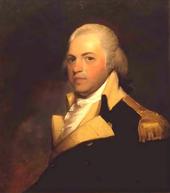Light-horse
Light-horse Harry Lee
Henry Lee III, called "Light Horse Harry", (January 29, 1756 – March 25, 1818) was a cavalry officer in the Continental Army during the American Revolution. He was the Governor of Virginia and a U.S. Congressman, as well as the father of American Civil War general Robert E. Lee.
Lee was born near Dumfries, Virginia. Henry was the son of Maj. Gen. Henry Lee II (1730-1787) of "Leesylvania" and, Lucy Grymes (1734-1792) the "Lowland Beauty". His father was first cousin once removed to Richard Henry Lee, sixth President of the Continental Congress. With a view to a legal career, he graduated (1773) from The College of New Jersey (now Princeton University), but, soon afterwards, on the outbreak of the Revolutionary War, he became an officer in the revolutionary forces.
In 1776, he was promoted to captain of a Virginia Dragoon detachment, which was attached to the 1st Continental Light Dragoons; and, in 1778, he was promoted to major and given the command of a small irregular corps, with which he won a great reputation as a leader of light troops.
His services on the outpost line of the army earned for him the soubriquet of "Light Horse Harry". His greatest exploit was the brilliant surprise at the Battle of Paulus Hook in New Jersey, on August 19, 1779; for this feat he received a gold medal, a reward given to no other officer below a general's rank in the entire war. See also Discovery of medal that Congress granted to Lee.
He was promoted to lieutenant colonel with a picked corps of dragoons (Lee's Legion) to the southern theatre of war. Here he rendered invaluable services in victory and defeat, notably at Guilford Court House, Camden and Eutaw Springs. He was present at Cornwallis's surrender at Yorktown, and afterwards left the army owing to ill health.
During the infamous Whiskey Rebellion, Lee commanded the 13,000 militiamen sent to quash the rebels. However, this command existed more on paper than in actuality, as President George Washington and Alexander Hamilton, military men both, accompanied him.
On 13 June 1793, Henry Lee married the wealthy Anne Hill Carter (17 years his junior) at Shirley Plantation. They had six children, one of whom died in infancy in 1796. Their fifth child, Robert Edward Lee would later gain fame as a Confederate general during the American Civil War.
Unfortunately for Lee and his family, he invested large sums in numerous, highly speculative schemes, including partnerships with Aaron Burr and Robert Morris (merchant). Although financial speculation was not rare among the Founding Fathers, Lee's handling of his personal finances was notably incompetent, and subjected his family to financial hardship. In 1810, to meet the demands of his creditors and be released from debtor’s prison, Lee was forced to sell all of his possessions.
From 1786 to 1788, Lee was a delegate to the Continental Congress, and in the last-named year in the Virginia convention, he favored the adoption of the United States Constitution. From 1789 to 1791, he served in the General Assembly and, from 1791 to 1794, was Governor of Virginia.
In 1794, Lee accompanied Washington to help in the suppression of the "Whiskey Rebellion" in western Pennsylvania. A new county of Virginia was named after him during his governorship. Henry Lee was a major-general in the U.S. Army in 1798-1800. From 1799 to 1801, he served in the United States House of Representatives of the Congress. He wrote the famous phrase used by John Marshall in the address to Congress on the death of Washington - "first in war, first in peace, and first in the hearts of his countrymen."
On 27 July 1812, in Baltimore, while helping to resist the attack of a Democratic-Republican mob on his friend, Alexander Contee Hanson, editor of the Baltimore Federal Republican, which had opposed the War of 1812, Lee received grave injuries from which he never recovered.
Lee and about two dozen Federalists had taken refuge in the three-story office building on Charles Street. With the help of Brigadier General John Stricker and other city officials, Lee and the rest surrendered the following day and were escorted to the county jail a mile away. Laborer George Woolslager led a mob that forced its way into the jail and removed and beat the jailed Federalists and Lee over the next three hours. One Federalist, James M. Lingan, died.
Lee suffered extensive internal injuries as well as head and face wounds, and even his speech was affected. Lee later sailed to the West Indies in an attempt to heal his wounds. He died at "Dungeness" on March 25, 1818 (Dungeness was built on Cumberland Island, Georgia by Nathaneal Greene as a summer home). Greene's daughter Louisa was in possession of the house at the time of Lee's death.
Lee was buried with full military honors provided by an American fleet stationed near the St. Marys. For many years his body rested in the same little cemetery as Louisa's mother, Catherine, but in 1913 his remains were removed to the Lee family crypt at Lee Chapel, on the campus of Washington & Lee University in Lexington, Virginia.
Lee Coat of Arms
Stratford
Lee's Congressional Medal
Try the BEST MySpace Editor and MySpace Backgrounds at MySpace Toolbox !
